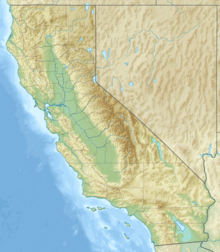Kingston Range facts for kids
Quick facts for kids Kingston Range |
|
|---|---|

Kingston Range, Mojave Desert
|
|
| Highest point | |
| Peak | Kingston Peak |
| Elevation | 7,323 ft (2,232 m) |
| Geography | |
| Country | United States |
| State | California |
| Region | Mojave Desert |
| District | San Bernardino County |
| Range coordinates | 35°47′2.900″N 115°54′7.049″W / 35.78413889°N 115.90195806°W |
| Topo map | USGS Horse Thief Springs |
The Kingston Range, also known as the Kingston Mountains, is a mountain range in eastern California. It is found in Inyo and San Bernardino counties. This range is part of the Mojave Desert. The highest point is Kingston Peak, which stands at 7,323 feet (2,232 m) above sea level.
The Kingston Range is located southeast of the Nopah Range. It is north of the Shadow Mountains and Interstate 15. The small town of Halloran Springs is about 22 miles (35 km) south. The range stretches for about 18 mi (29 km) from northeast to southwest. Tecopa Pass is at the northeastern end of these mountains. It is 5,100 ft (1,600 m) high.
Contents
Exploring the Kingston Range Wilderness
The Kingston Range Wilderness is a special protected area. The U.S. Congress created it in 1994. It covers 252,149 acres. This wilderness is made of three separate parts. These parts are divided by areas that are not wilderness.
What is a Wilderness Area?
A wilderness area is a place kept wild and natural. It is protected by the government. This helps to save its plants, animals, and natural beauty. People can visit, but they must leave no trace. This means no buildings or roads are allowed.
Unique Ecosystems of the Kingston Range
This area is important because it protects a special "transition zone." This is where two deserts meet: the Great Basin and the Mojave Desert. This mix of environments allows many different plants and animals to live here.
The Three Units of the Wilderness
The Kingston Range Wilderness has three main sections:
- The Amargosa unit is in the north. It includes Amargosa Canyon. This area has desert wetlands. These wetlands are home to many different birds and water creatures.
- The Kingston unit is in the middle. It includes the Kingston Mountains themselves. This part has a 17-mile long ridge. Kingston Peak, the highest point, is in this unit.
- The Shadow Mountain unit is in the south. It covers the lower Shadow Mountains.
Amazing Plants of the Kingston Range
There are 505 different types of native plants in this wilderness. At lower elevations, you can find Creosote bush plants. Higher up, there are juniper and pinyon trees. This desert wilderness has many different kinds of plants. It is home to the only group of Giant nolina plants in the eastern Mojave Desert. You can also find white fir trees. These trees grow on the slopes below Kingston Peak.
Wildlife of the Kingston Range
The Kingston Range is home to many interesting animals. You might see the banded gila monster, a type of lizard. Bighorn sheep also live here. Wild burros, coyotes, and black-tailed jackrabbits are common. Smaller animals include ground squirrels and kangaroo rats. Birds like roadrunners and quail fly around. You might also spot rattlesnakes, tarantulas, and different kinds of lizards. The desert tortoise, a protected species, also lives here.


